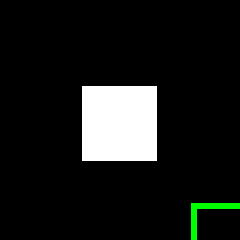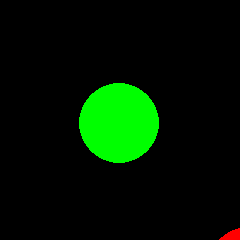How do I detect collision in pygame?
Question:
I have made a list of bullets and a list of sprites using the classes below. How do I detect if a bullet collides with a sprite and then delete that sprite and the bullet?
#Define the sprite class
class Sprite:
def __init__(self,x,y, name):
self.x=x
self.y=y
self.image = pygame.image.load(name)
self.rect = self.image.get_rect()
def render(self):
window.blit(self.image, (self.x,self.y))
# Define the bullet class to create bullets
class Bullet:
def __init__(self,x,y):
self.x = x + 23
self.y = y
self.bullet = pygame.image.load("user_bullet.BMP")
self.rect = self.bullet.get_rect()
def render(self):
window.blit(self.bullet, (self.x, self.y))
Answers:
From what I understand of pygame you just need to check if the two rectangles overlap using the colliderect method. One way to do it is to have a method in your Bullet class that checks for collisions:
def is_collided_with(self, sprite):
return self.rect.colliderect(sprite.rect)
Then you can call it like:
sprite = Sprite(10, 10, 'my_sprite')
bullet = Bullet(20, 10)
if bullet.is_collided_with(sprite):
print('collision!')
bullet.kill()
sprite.kill()
There is a very simple method for what you are trying to do using built in methods.
here is an example.
import pygame
import sys
class Sprite(pygame.sprite.Sprite):
def __init__(self, pos):
pygame.sprite.Sprite.__init__(self)
self.image = pygame.Surface([20, 20])
self.image.fill((255, 0, 0))
self.rect = self.image.get_rect()
self.rect.center = pos
def main():
pygame.init()
clock = pygame.time.Clock()
fps = 50
bg = [255, 255, 255]
size =[200, 200]
screen = pygame.display.set_mode(size)
player = Sprite([40, 50])
player.move = [pygame.K_LEFT, pygame.K_RIGHT, pygame.K_UP, pygame.K_DOWN]
player.vx = 5
player.vy = 5
wall = Sprite([100, 60])
wall_group = pygame.sprite.Group()
wall_group.add(wall)
player_group = pygame.sprite.Group()
player_group.add(player)
# I added loop for a better exit from the game
loop = 1
while loop:
for event in pygame.event.get():
if event.type == pygame.QUIT:
loop = 0
key = pygame.key.get_pressed()
for i in range(2):
if key[player.move[i]]:
player.rect.x += player.vx * [-1, 1][i]
for i in range(2):
if key[player.move[2:4][i]]:
player.rect.y += player.vy * [-1, 1][i]
screen.fill(bg)
# first parameter takes a single sprite
# second parameter takes sprite groups
# third parameter is a do kill command if true
# all group objects colliding with the first parameter object will be
# destroyed. The first parameter could be bullets and the second one
# targets although the bullet is not destroyed but can be done with
# simple trick bellow
hit = pygame.sprite.spritecollide(player, wall_group, True)
if hit:
# if collision is detected call a function in your case destroy
# bullet
player.image.fill((255, 255, 255))
player_group.draw(screen)
wall_group.draw(screen)
pygame.display.update()
clock.tick(fps)
pygame.quit()
# sys.exit
if __name__ == '__main__':
main()
Make a group for the bullets, and then add the bullets to the group.
What I would do is this:
In the class for the player:
def collideWithBullet(self):
if pygame.sprite.spritecollideany(self, 'groupName'):
print("CollideWithBullet!!")
return True
And in the main loop somewhere:
def run(self):
if self.player.collideWithBullet():
print("Game Over")
Hopefully that works for you!!!
In PyGame, collision detection is done using pygame.Rect objects. The Rect object offers various methods for detecting collisions between objects. Even the collision between a rectangular and circular object such as a paddle and a ball can be detected by a collision between two rectangular objects, the paddle and the bounding rectangle of the ball.
Some examples:
-
Test if a point is inside a rectangle
 repl.it/@Rabbid76/PyGame-collidepoint
repl.it/@Rabbid76/PyGame-collidepoint
import pygame
pygame.init()
window = pygame.display.set_mode((250, 250))
rect = pygame.Rect(*window.get_rect().center, 0, 0).inflate(100, 100)
run = True
while run:
for event in pygame.event.get():
if event.type == pygame.QUIT:
run = False
point = pygame.mouse.get_pos()
collide = rect.collidepoint(point)
color = (255, 0, 0) if collide else (255, 255, 255)
window.fill(0)
pygame.draw.rect(window, color, rect)
pygame.display.flip()
pygame.quit()
exit()
-
Test if two rectangles overlap
See also How to detect collisions between two rectangular objects or images in pygame
 repl.it/@Rabbid76/PyGame-colliderect
repl.it/@Rabbid76/PyGame-colliderect
import pygame
pygame.init()
window = pygame.display.set_mode((250, 250))
rect1 = pygame.Rect(*window.get_rect().center, 0, 0).inflate(75, 75)
rect2 = pygame.Rect(0, 0, 75, 75)
run = True
while run:
for event in pygame.event.get():
if event.type == pygame.QUIT:
run = False
rect2.center = pygame.mouse.get_pos()
collide = rect1.colliderect(rect2)
color = (255, 0, 0) if collide else (255, 255, 255)
window.fill(0)
pygame.draw.rect(window, color, rect1)
pygame.draw.rect(window, (0, 255, 0), rect2, 6, 1)
pygame.display.flip()
pygame.quit()
exit()
Furthermore, pygame.Rect.collidelist and pygame.Rect.collidelistall can be used for the collision test between a rectangle and a list of rectangles. pygame.Rect.collidedict and pygame.Rect.collidedictall can be used for the collision test between a rectangle and a dictionary of rectangles.
The collision of pygame.sprite.Sprite and pygame.sprite.Group objects, can be detected by pygame.sprite.spritecollide(), pygame.sprite.groupcollide() or pygame.sprite.spritecollideany(). When using these methods, the collision detection algorithm can be specified by the collided argument:
The collided argument is a callback function used to calculate if two sprites are colliding.
Possible collided callables are collide_rect, collide_rect_ratio, collide_circle, collide_circle_ratio, collide_mask
Some examples:
-
 repl.it/@Rabbid76/PyGame-spritecollide
repl.it/@Rabbid76/PyGame-spritecollide
import pygame
pygame.init()
window = pygame.display.set_mode((250, 250))
sprite1 = pygame.sprite.Sprite()
sprite1.image = pygame.Surface((75, 75))
sprite1.image.fill((255, 0, 0))
sprite1.rect = pygame.Rect(*window.get_rect().center, 0, 0).inflate(75, 75)
sprite2 = pygame.sprite.Sprite()
sprite2.image = pygame.Surface((75, 75))
sprite2.image.fill((0, 255, 0))
sprite2.rect = pygame.Rect(*window.get_rect().center, 0, 0).inflate(75, 75)
all_group = pygame.sprite.Group([sprite2, sprite1])
test_group = pygame.sprite.Group(sprite2)
run = True
while run:
for event in pygame.event.get():
if event.type == pygame.QUIT:
run = False
sprite1.rect.center = pygame.mouse.get_pos()
collide = pygame.sprite.spritecollide(sprite1, test_group, False)
window.fill(0)
all_group.draw(window)
for s in collide:
pygame.draw.rect(window, (255, 255, 255), s.rect, 5, 1)
pygame.display.flip()
pygame.quit()
exit()
For a collision with masks, see How can I make a collision mask? or Pygame mask collision
See also Collision and Intersection
-
pygame.sprite.spritecollide() / collide_circle
 repl.it/@Rabbid76/PyGame-spritecollidecollidecircle
repl.it/@Rabbid76/PyGame-spritecollidecollidecircle
import pygame
pygame.init()
window = pygame.display.set_mode((250, 250))
sprite1 = pygame.sprite.Sprite()
sprite1.image = pygame.Surface((80, 80), pygame.SRCALPHA)
pygame.draw.circle(sprite1.image, (255, 0, 0), (40, 40), 40)
sprite1.rect = pygame.Rect(*window.get_rect().center, 0, 0).inflate(80, 80)
sprite1.radius = 40
sprite2 = pygame.sprite.Sprite()
sprite2.image = pygame.Surface((80, 89), pygame.SRCALPHA)
pygame.draw.circle(sprite2.image, (0, 255, 0), (40, 40), 40)
sprite2.rect = pygame.Rect(*window.get_rect().center, 0, 0).inflate(80, 80)
sprite2.radius = 40
all_group = pygame.sprite.Group([sprite2, sprite1])
test_group = pygame.sprite.Group(sprite2)
run = True
while run:
for event in pygame.event.get():
if event.type == pygame.QUIT:
run = False
sprite1.rect.center = pygame.mouse.get_pos()
collide = pygame.sprite.spritecollide(sprite1, test_group, False, pygame.sprite.collide_circle)
window.fill(0)
all_group.draw(window)
for s in collide:
pygame.draw.circle(window, (255, 255, 255), s.rect.center, s.rect.width // 2, 5)
pygame.display.flip()
pygame.quit()
exit()
What does this all mean for your code?
pygame.Surface.get_rect.get_rect() returns a rectangle with the size of the Surface object, that always starts at (0, 0) since a Surface object has no position. The position of the rectangle can be specified by a keyword argument. For example, the centre of the rectangle can be specified with the keyword argument center. These keyword arguments are applied to the attributes of the pygame.Rect before it is returned (see pygame.Rect for a list of the keyword arguments).
See *Why is my collision test always returning ‘true’ and why is the position of the rectangle of the image always wrong (0, 0)?
You do not need the x and y attributes of Sprite and Bullet at all. Use the position of the rect attribute instead:
#Define the sprite class
class Sprite:
def __init__(self, x, y, name):
self.image = pygame.image.load(name)
self.rect = self.image.get_rect(topleft = (x, y))
def render(self):
window.blit(self.image, self.rect)
# Define the bullet class to create bullets
class Bullet:
def __init__(self, x, y):
self.bullet = pygame.image.load("user_bullet.BMP")
self.rect = self.bullet.get_rect(topleft = (x + 23, y))
def render(self):
window.blit(self.bullet, self.rect)
Use pygame.Rect.colliderect() to detect collisions between instances of Sprite and Bullet.
See How to detect collisions between two rectangular objects or images in pygame:
my_sprite = Sprite(sx, sy, name)
my_bullet = Bullet(by, by)
while True:
# [...]
if my_sprite.rect.colliderect(my_bullet.rect):
printe("hit")
Inside the Sprite class, try adding a self.mask attribute with
self.mask = pygame.mask.from_surface(self.image)
and a collide_mask function inside of the Sprite class with this code:
def collide_mask(self, mask):
collided = False
mask_outline = mask.outline()
self.mask_outline = self.mask.outline()
for point in range(len(mask_outline)):
mask_outline[point] = list(mask_outline[point])
mask_outline[point][0] += bullet.x
mask_outline[point][1] += bullet.y
for point in range(len(self.mask_outline)):
self.mask_outline[point] = list(mask_outline[point])
self.mask_outline[point][0] += self.x
self.mask_outline[point][1] += self.y
for point in mask_outline:
for self_mask_point in self.mask_outline:
if point = self_mask_point:
collided = True
return collided
I have made a list of bullets and a list of sprites using the classes below. How do I detect if a bullet collides with a sprite and then delete that sprite and the bullet?
#Define the sprite class
class Sprite:
def __init__(self,x,y, name):
self.x=x
self.y=y
self.image = pygame.image.load(name)
self.rect = self.image.get_rect()
def render(self):
window.blit(self.image, (self.x,self.y))
# Define the bullet class to create bullets
class Bullet:
def __init__(self,x,y):
self.x = x + 23
self.y = y
self.bullet = pygame.image.load("user_bullet.BMP")
self.rect = self.bullet.get_rect()
def render(self):
window.blit(self.bullet, (self.x, self.y))
From what I understand of pygame you just need to check if the two rectangles overlap using the colliderect method. One way to do it is to have a method in your Bullet class that checks for collisions:
def is_collided_with(self, sprite):
return self.rect.colliderect(sprite.rect)
Then you can call it like:
sprite = Sprite(10, 10, 'my_sprite')
bullet = Bullet(20, 10)
if bullet.is_collided_with(sprite):
print('collision!')
bullet.kill()
sprite.kill()
There is a very simple method for what you are trying to do using built in methods.
here is an example.
import pygame
import sys
class Sprite(pygame.sprite.Sprite):
def __init__(self, pos):
pygame.sprite.Sprite.__init__(self)
self.image = pygame.Surface([20, 20])
self.image.fill((255, 0, 0))
self.rect = self.image.get_rect()
self.rect.center = pos
def main():
pygame.init()
clock = pygame.time.Clock()
fps = 50
bg = [255, 255, 255]
size =[200, 200]
screen = pygame.display.set_mode(size)
player = Sprite([40, 50])
player.move = [pygame.K_LEFT, pygame.K_RIGHT, pygame.K_UP, pygame.K_DOWN]
player.vx = 5
player.vy = 5
wall = Sprite([100, 60])
wall_group = pygame.sprite.Group()
wall_group.add(wall)
player_group = pygame.sprite.Group()
player_group.add(player)
# I added loop for a better exit from the game
loop = 1
while loop:
for event in pygame.event.get():
if event.type == pygame.QUIT:
loop = 0
key = pygame.key.get_pressed()
for i in range(2):
if key[player.move[i]]:
player.rect.x += player.vx * [-1, 1][i]
for i in range(2):
if key[player.move[2:4][i]]:
player.rect.y += player.vy * [-1, 1][i]
screen.fill(bg)
# first parameter takes a single sprite
# second parameter takes sprite groups
# third parameter is a do kill command if true
# all group objects colliding with the first parameter object will be
# destroyed. The first parameter could be bullets and the second one
# targets although the bullet is not destroyed but can be done with
# simple trick bellow
hit = pygame.sprite.spritecollide(player, wall_group, True)
if hit:
# if collision is detected call a function in your case destroy
# bullet
player.image.fill((255, 255, 255))
player_group.draw(screen)
wall_group.draw(screen)
pygame.display.update()
clock.tick(fps)
pygame.quit()
# sys.exit
if __name__ == '__main__':
main()
Make a group for the bullets, and then add the bullets to the group.
What I would do is this:
In the class for the player:
def collideWithBullet(self):
if pygame.sprite.spritecollideany(self, 'groupName'):
print("CollideWithBullet!!")
return True
And in the main loop somewhere:
def run(self):
if self.player.collideWithBullet():
print("Game Over")
Hopefully that works for you!!!
In PyGame, collision detection is done using pygame.Rect objects. The Rect object offers various methods for detecting collisions between objects. Even the collision between a rectangular and circular object such as a paddle and a ball can be detected by a collision between two rectangular objects, the paddle and the bounding rectangle of the ball.
Some examples:
-
Test if a point is inside a rectangle
 repl.it/@Rabbid76/PyGame-collidepoint
repl.it/@Rabbid76/PyGame-collidepointimport pygame pygame.init() window = pygame.display.set_mode((250, 250)) rect = pygame.Rect(*window.get_rect().center, 0, 0).inflate(100, 100) run = True while run: for event in pygame.event.get(): if event.type == pygame.QUIT: run = False point = pygame.mouse.get_pos() collide = rect.collidepoint(point) color = (255, 0, 0) if collide else (255, 255, 255) window.fill(0) pygame.draw.rect(window, color, rect) pygame.display.flip() pygame.quit() exit() -
Test if two rectangles overlap
See also How to detect collisions between two rectangular objects or images in pygame
 repl.it/@Rabbid76/PyGame-colliderect
repl.it/@Rabbid76/PyGame-colliderectimport pygame pygame.init() window = pygame.display.set_mode((250, 250)) rect1 = pygame.Rect(*window.get_rect().center, 0, 0).inflate(75, 75) rect2 = pygame.Rect(0, 0, 75, 75) run = True while run: for event in pygame.event.get(): if event.type == pygame.QUIT: run = False rect2.center = pygame.mouse.get_pos() collide = rect1.colliderect(rect2) color = (255, 0, 0) if collide else (255, 255, 255) window.fill(0) pygame.draw.rect(window, color, rect1) pygame.draw.rect(window, (0, 255, 0), rect2, 6, 1) pygame.display.flip() pygame.quit() exit()
Furthermore, pygame.Rect.collidelist and pygame.Rect.collidelistall can be used for the collision test between a rectangle and a list of rectangles. pygame.Rect.collidedict and pygame.Rect.collidedictall can be used for the collision test between a rectangle and a dictionary of rectangles.
The collision of pygame.sprite.Sprite and pygame.sprite.Group objects, can be detected by pygame.sprite.spritecollide(), pygame.sprite.groupcollide() or pygame.sprite.spritecollideany(). When using these methods, the collision detection algorithm can be specified by the collided argument:
The collided argument is a callback function used to calculate if two sprites are colliding.
Possible collided callables are collide_rect, collide_rect_ratio, collide_circle, collide_circle_ratio, collide_mask
Some examples:
-
 repl.it/@Rabbid76/PyGame-spritecollide
repl.it/@Rabbid76/PyGame-spritecollideimport pygame pygame.init() window = pygame.display.set_mode((250, 250)) sprite1 = pygame.sprite.Sprite() sprite1.image = pygame.Surface((75, 75)) sprite1.image.fill((255, 0, 0)) sprite1.rect = pygame.Rect(*window.get_rect().center, 0, 0).inflate(75, 75) sprite2 = pygame.sprite.Sprite() sprite2.image = pygame.Surface((75, 75)) sprite2.image.fill((0, 255, 0)) sprite2.rect = pygame.Rect(*window.get_rect().center, 0, 0).inflate(75, 75) all_group = pygame.sprite.Group([sprite2, sprite1]) test_group = pygame.sprite.Group(sprite2) run = True while run: for event in pygame.event.get(): if event.type == pygame.QUIT: run = False sprite1.rect.center = pygame.mouse.get_pos() collide = pygame.sprite.spritecollide(sprite1, test_group, False) window.fill(0) all_group.draw(window) for s in collide: pygame.draw.rect(window, (255, 255, 255), s.rect, 5, 1) pygame.display.flip() pygame.quit() exit()
For a collision with masks, see How can I make a collision mask? or Pygame mask collision
See also Collision and Intersection
-
pygame.sprite.spritecollide()/collide_circle repl.it/@Rabbid76/PyGame-spritecollidecollidecircle
repl.it/@Rabbid76/PyGame-spritecollidecollidecircleimport pygame pygame.init() window = pygame.display.set_mode((250, 250)) sprite1 = pygame.sprite.Sprite() sprite1.image = pygame.Surface((80, 80), pygame.SRCALPHA) pygame.draw.circle(sprite1.image, (255, 0, 0), (40, 40), 40) sprite1.rect = pygame.Rect(*window.get_rect().center, 0, 0).inflate(80, 80) sprite1.radius = 40 sprite2 = pygame.sprite.Sprite() sprite2.image = pygame.Surface((80, 89), pygame.SRCALPHA) pygame.draw.circle(sprite2.image, (0, 255, 0), (40, 40), 40) sprite2.rect = pygame.Rect(*window.get_rect().center, 0, 0).inflate(80, 80) sprite2.radius = 40 all_group = pygame.sprite.Group([sprite2, sprite1]) test_group = pygame.sprite.Group(sprite2) run = True while run: for event in pygame.event.get(): if event.type == pygame.QUIT: run = False sprite1.rect.center = pygame.mouse.get_pos() collide = pygame.sprite.spritecollide(sprite1, test_group, False, pygame.sprite.collide_circle) window.fill(0) all_group.draw(window) for s in collide: pygame.draw.circle(window, (255, 255, 255), s.rect.center, s.rect.width // 2, 5) pygame.display.flip() pygame.quit() exit()
What does this all mean for your code?
pygame.Surface.get_rect.get_rect() returns a rectangle with the size of the Surface object, that always starts at (0, 0) since a Surface object has no position. The position of the rectangle can be specified by a keyword argument. For example, the centre of the rectangle can be specified with the keyword argument center. These keyword arguments are applied to the attributes of the pygame.Rect before it is returned (see pygame.Rect for a list of the keyword arguments).
See *Why is my collision test always returning ‘true’ and why is the position of the rectangle of the image always wrong (0, 0)?
You do not need the x and y attributes of Sprite and Bullet at all. Use the position of the rect attribute instead:
#Define the sprite class
class Sprite:
def __init__(self, x, y, name):
self.image = pygame.image.load(name)
self.rect = self.image.get_rect(topleft = (x, y))
def render(self):
window.blit(self.image, self.rect)
# Define the bullet class to create bullets
class Bullet:
def __init__(self, x, y):
self.bullet = pygame.image.load("user_bullet.BMP")
self.rect = self.bullet.get_rect(topleft = (x + 23, y))
def render(self):
window.blit(self.bullet, self.rect)
Use pygame.Rect.colliderect() to detect collisions between instances of Sprite and Bullet.
See How to detect collisions between two rectangular objects or images in pygame:
my_sprite = Sprite(sx, sy, name)
my_bullet = Bullet(by, by)
while True:
# [...]
if my_sprite.rect.colliderect(my_bullet.rect):
printe("hit")
Inside the Sprite class, try adding a self.mask attribute with
self.mask = pygame.mask.from_surface(self.image)
and a collide_mask function inside of the Sprite class with this code:
def collide_mask(self, mask):
collided = False
mask_outline = mask.outline()
self.mask_outline = self.mask.outline()
for point in range(len(mask_outline)):
mask_outline[point] = list(mask_outline[point])
mask_outline[point][0] += bullet.x
mask_outline[point][1] += bullet.y
for point in range(len(self.mask_outline)):
self.mask_outline[point] = list(mask_outline[point])
self.mask_outline[point][0] += self.x
self.mask_outline[point][1] += self.y
for point in mask_outline:
for self_mask_point in self.mask_outline:
if point = self_mask_point:
collided = True
return collided



